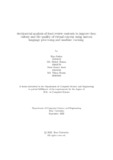Sentimental analysis of food review contents to improve food culture and the quality of virtual content using natural language processing and machine learning
Abstract
Internet-based applications like social media platforms and blogs have exploded in
popularity, and with them have come reviews and commentary on people’s daily
lives. Unfortunately, the vast majority of these evaluations and commentary are
critical. even in material devoted to reviewing food, like food blogs, vlogs and cook ing videos. Data collection and analysis based on people’s subjective feelings about
a certain topic, product, subject, or service is known as sentiment analysis. By using
techniques from natural language processing and text mining, sentiment analysis is
able to recognize and extract empathetic details from written content. In this study,
we’ll go through a high-level introduction to the process for doing so, as well as the
uses of sentiment analysis. After that, it analyzes the methods in order to weigh
their merits and drawbacks via a series of comparisons and assessments. Several
classifiers (Logistic Regression, Multinomial Naive Bayes, K-Nearest Neighbors, De cision Tree, Random Forest, AdaBoost, and SVM) are used to divide the sentiment
into one of three categories, like positive, negative, or sarcastic.

